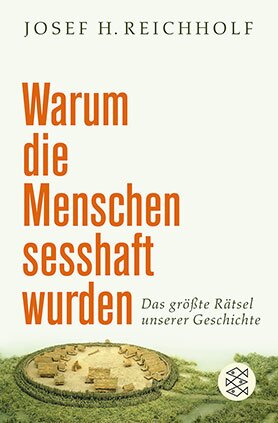Josef H. Reichholf
Warum die Menschen sesshaft wurden. Das größte Rätsel unserer Geschichte
[Why man settled. The greatest puzzle in our history]
- S. Fischer Verlag
- Frankfurt am Main 2008
- ISBN 978-3-10-062943-2
- 320 Pages
- Publisher’s contact details
Josef H. Reichholf
Warum die Menschen sesshaft wurden. Das größte Rätsel unserer Geschichte
[Why man settled. The greatest puzzle in our history]
This book was showcased during the special focus on Portuguese: Brazil (2007 - 2008).
Sample translations
Review
What transformed humans from hunters into farmers? Roughly 12,000 years ago something occurred that continues to define our world today. After millennia of nomadic existence, hunters suddenly settled and began to cultivate the soil. This development is known as the “Neolithic Revolution,” the transition from the Stone Age to historical times. Yet there is much speculation as to the causes of the changeover and how it unfolded. In a new book entitled “Why Man Settled,” renowned evolutionary biologist Joseph H. Reichholf also delves into this question. And he arrives at a surprising conclusion: in the beginning, living in settlements didn’t come about from need or hunger, but was based on raucous festivity and the discovery of alcohol.
An old proverb has it that necessity is the mother of invention. Many theories of human development are also based on this notion. For example, the evolutionary development of Homo sapiens has been attributed to the shrinkage of African forests, which forced man to walk upright in the grass steppes. Most speculation over the “Neolithic Revolution” was based on similar explanations. Supposedly, it was a dearth of game animals at the end of the last ice age that constrained hunter-gatherers to settle, with grain becoming a substitute for meat.
Reichholf presents conclusive arguments against these theories. He claims that abundance, not need, turned humans into resourceful civilized beings and served as the catalyst for change, both with respect to the emergence of humans as well as their shift from a hunter-gathering way of life to agriculture.
The author shows that our ancestors’ path into the open savanna was based on evolutionary advantages and not on the disappearance of the forests. For it was only ongoing reproductive success that turned plant-eating primates into the predator Homo sapiens. Cadavers, and later large game that had been brought down, provided meat containing disproportionately more protein than a fruit and plant-based diet. This protein surplus secured two crucial selection advantages for the emerging human species. It allowed childbearing females to receive optimal nutrition, thereby increasing the number of offspring, while at the same time also enabling the offspring to receive better food. The result was an enormous rise in the number of progeny.
Human beings only became possible through the evolutionary advantages offered by a carnivorous diet. Yet it would still take thousands of years to turn mankind into what we are today: naked runners with extreme endurance and a better cooling system than any other mammal, i.e., perspiration. This enabled humans, as opposed to other predators, to follow their sources of meat and profit continually from the excess of large game herds.
Reichholf fields similar arguments with respect to human civilization. For although mankind has, so to speak, removed itself from natural evolution through its capacity for civilization, when it comes to cultural developments “fluidity holds sway over that which is delimitable and constant.” In his opinion, this also applies to the “Neolithic Revolution.” It was not a revolution in the strict sense of the word but a gradual transition that ended with the triumph of agriculture. In this respect, Reichholf does not yet diverge from “mainstream science.” In order to substantiate his theory, however, he analyzes the standard interpretations and points out the loopholes in the “need hypothesis,” which postulates that mankind had to adjust due to a scarcity of game. Yet the “fertile crescent,” the region where agriculture arose, possessed abundant vegetation that was entirely capable of supporting game. Why should this very thing have been in short supply? But even more convincing are the calculations Reichholf makes for energy balance. Three kilograms of grain per person per day would have been required to make up for a protein-rich meat diet. This means that a family would have needed some five tons of grain annually. And this accounting does not yet reflect losses caused by pests, or the fact that the original, primitive forms of grain produced far lower yields than today’s cultivated varieties. This calculation in itself debunks the simple “need hypothesis.”
Yet why did man begin planting crops in the first place? Reichholf’s answer is as surprising as it is convincing: because of alcohol. Initially, the amount of wild grain was insufficient to replace meat, but it had now became possible to produce alcohol through fermentation. This fulfilled several functions. As an intoxicant at festivities, alcohol strengthened the community. At the same time, enzymes produced during the fermentation process break down plant substances that are difficult to digest, thereby making additional nutrients available. Indeed, the first verifiable record of grain cultivation did not involve wheat but rather barley, which is still used to make beer today. According to Reichholf, it was only later that beer mash turned into sourdough for baking bread. Tellingly, alcohol tolerance is still highest today in the cultures where bread is a nutritional staple. Reichholf presents much additional and surprising evidence for his theory. He cites other intoxicants as well and investigates their influence on the discovery of crops such as maize, rice, or potatoes.
“Why Man Settled” is a colorful journey through early human history, from the origin of our species to ice age hunters, domestic animals, and the relationship between language, drugs, and culture. Reichholf omits nothing; even the unicorn finds a place in his account. Despite the fact that all of his points do not seem immediately obvious, his argumentation is ultimately convincing because he supports his theory with the latest findings from biology, anthropology, archaeology, molecular genetics, and linguistics. Thus, the author’s reasoning is well-founded, understandable, and riveting. He succeeds in providing understandable explanations even for the complex details of evolutionary biology. This book has the rare quality of being able to convey trailblazing scientific insights in an entertaining form. Reichholf’s look back into the past of our species contains exciting food for thought on the questions of where man comes from as well as where our origins might still lead us.

An old proverb has it that necessity is the mother of invention. Many theories of human development are also based on this notion. For example, the evolutionary development of Homo sapiens has been attributed to the shrinkage of African forests, which forced man to walk upright in the grass steppes. Most speculation over the “Neolithic Revolution” was based on similar explanations. Supposedly, it was a dearth of game animals at the end of the last ice age that constrained hunter-gatherers to settle, with grain becoming a substitute for meat.
Reichholf presents conclusive arguments against these theories. He claims that abundance, not need, turned humans into resourceful civilized beings and served as the catalyst for change, both with respect to the emergence of humans as well as their shift from a hunter-gathering way of life to agriculture.
The author shows that our ancestors’ path into the open savanna was based on evolutionary advantages and not on the disappearance of the forests. For it was only ongoing reproductive success that turned plant-eating primates into the predator Homo sapiens. Cadavers, and later large game that had been brought down, provided meat containing disproportionately more protein than a fruit and plant-based diet. This protein surplus secured two crucial selection advantages for the emerging human species. It allowed childbearing females to receive optimal nutrition, thereby increasing the number of offspring, while at the same time also enabling the offspring to receive better food. The result was an enormous rise in the number of progeny.
Human beings only became possible through the evolutionary advantages offered by a carnivorous diet. Yet it would still take thousands of years to turn mankind into what we are today: naked runners with extreme endurance and a better cooling system than any other mammal, i.e., perspiration. This enabled humans, as opposed to other predators, to follow their sources of meat and profit continually from the excess of large game herds.
Reichholf fields similar arguments with respect to human civilization. For although mankind has, so to speak, removed itself from natural evolution through its capacity for civilization, when it comes to cultural developments “fluidity holds sway over that which is delimitable and constant.” In his opinion, this also applies to the “Neolithic Revolution.” It was not a revolution in the strict sense of the word but a gradual transition that ended with the triumph of agriculture. In this respect, Reichholf does not yet diverge from “mainstream science.” In order to substantiate his theory, however, he analyzes the standard interpretations and points out the loopholes in the “need hypothesis,” which postulates that mankind had to adjust due to a scarcity of game. Yet the “fertile crescent,” the region where agriculture arose, possessed abundant vegetation that was entirely capable of supporting game. Why should this very thing have been in short supply? But even more convincing are the calculations Reichholf makes for energy balance. Three kilograms of grain per person per day would have been required to make up for a protein-rich meat diet. This means that a family would have needed some five tons of grain annually. And this accounting does not yet reflect losses caused by pests, or the fact that the original, primitive forms of grain produced far lower yields than today’s cultivated varieties. This calculation in itself debunks the simple “need hypothesis.”
Yet why did man begin planting crops in the first place? Reichholf’s answer is as surprising as it is convincing: because of alcohol. Initially, the amount of wild grain was insufficient to replace meat, but it had now became possible to produce alcohol through fermentation. This fulfilled several functions. As an intoxicant at festivities, alcohol strengthened the community. At the same time, enzymes produced during the fermentation process break down plant substances that are difficult to digest, thereby making additional nutrients available. Indeed, the first verifiable record of grain cultivation did not involve wheat but rather barley, which is still used to make beer today. According to Reichholf, it was only later that beer mash turned into sourdough for baking bread. Tellingly, alcohol tolerance is still highest today in the cultures where bread is a nutritional staple. Reichholf presents much additional and surprising evidence for his theory. He cites other intoxicants as well and investigates their influence on the discovery of crops such as maize, rice, or potatoes.
“Why Man Settled” is a colorful journey through early human history, from the origin of our species to ice age hunters, domestic animals, and the relationship between language, drugs, and culture. Reichholf omits nothing; even the unicorn finds a place in his account. Despite the fact that all of his points do not seem immediately obvious, his argumentation is ultimately convincing because he supports his theory with the latest findings from biology, anthropology, archaeology, molecular genetics, and linguistics. Thus, the author’s reasoning is well-founded, understandable, and riveting. He succeeds in providing understandable explanations even for the complex details of evolutionary biology. This book has the rare quality of being able to convey trailblazing scientific insights in an entertaining form. Reichholf’s look back into the past of our species contains exciting food for thought on the questions of where man comes from as well as where our origins might still lead us.
Translated by Philip Schmitz

By Andrea Müller
